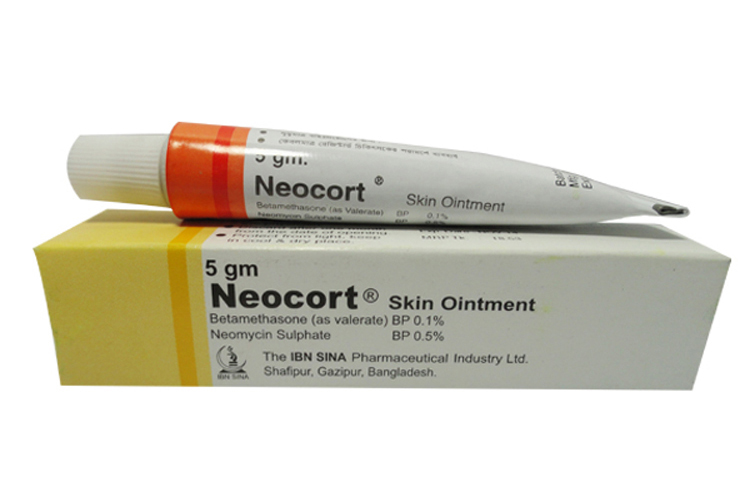
NEOCORT
NEOMYCIN BP & BETAMETHASON (AS VALERATE) BP
| NAME | STRENGTH | PACK SIZE | DOSAGE FORM |
|---|---|---|---|
| NEOCORT SKIN OINTMENT | 0.1% +0.5%. | 5 GM | OINTMENT |
Each gram of Neocort Cream/Ointment contains Betamethasone BP 0.1% as Valerate ester and Neomycin Sulphate BP 0.5%.
Neocort Cream/Ointment is a preparation of Betamethasone Valerate and Neomycin Sulphate. Betamethasone Valerate is a topical Corticosteroid having anti-inflammatory, antipruritic and vasocostrictor action. Neomycin Sulphate is a topical broad-spectrum, bactericidal aminoglycoside effective against the majority of bacteria commonly associated with skin infections. Topical corticosteroid is readily absorbed from the skin. In inflammatory condition, penetration is increased.
Neocort Cream/Ointment is indicated for the treatment of the following conditions where secondary bacterial infection is present, suspected or likely to occur: eczema including atopic, infantile and discoid eczemas; prurigo nodularis; psoriasis (excluding widespread plaque psoriasis); neurodermatoses, including lichen simplex, lichen planus; Seborrhoeic dermatitis; anal and genital intertrigo; contact sensitivity reactions; discoid lupus erythematosus. Neocort can also be used in the management of insect bites, prickly heat and otitis externa.
Apply a thin film to the affected skin areas one to three times a day or as advised by the physician.
Rosacea, acne vulgaris; peri-oral dermatitis; dermatosis in children under one year of age; skin lesions caused by infections with viruses (eg. Herpes simplex), fungi (eg. candidiasis, tinea) or bacteria (eg. impetigo). Cream/Ointment should not be used for the treatment of otitis externa where the ear drum is perforated, because of its risk of ototoxicity and in those patients hypersensitive to any of its components.
Long term continuous topical therapy should be avoided where possible, particularly in infants and children. If applied to the eyelid, care is needed to ensure that the preparation does not enter the eye, as glaucoma might occur.
Local adverse reactions have been reported particularly in occlusive dressing; also burning; itching, irritation, dryness, folliculitis, hypertrichosis, acniform may occur.
There are no data in humans to evaluate the effect of topical betamethasone valerate & neomycin sulphate on fertility. There are llimited data from the use of topical Betamethasone Valerate & Neomycin Sulphate in pregnant women. Topical administration of corticosteroids to pregnant animals can cause abnormalities of foetal development. However, neomycin present in maternal blood can cross the placenta and may give rise to a theoretical risk of foetal toxicity. Thus use of Betamethasone Valerate & Neomycin Sulphate is not recommended in pregnancy & lactation.
Co-administered drugs that can inhibit CYP3A4 (e.g. ritonavi,r itraconazole) have been shown to inhibit the metabolism of corticoste roids leading to increased systemic exposure. The extent to which this interaction is clinically relevant depends on the dose and route of administration of the corticosteroids and the potency of the CYP3A4 inhibitor. Following significant systemic absorption, Neomycin Sulphate can intensify and prolong the respiratory depressant effects of neuromuscular blocking agents. Possibility of cumulative toxicity should be considered when neomycin sulphate is applied topically in combination with systemic aminoglycoside therapy.
Symptoms and Signs: Topically applied Betamethasone Valerate & Neomycin Sulphate may be absorbed in sufficient amounts to produce systemic effects. Acute overdosage is very unlikely to occur, however, in the case of chronic overdosage or misuse, the features of hypercortisolism may occur.
Treatment: In the event of chronic overdose or misuse, topical corticosteroids should be withdrawn gradually by reducing the frequency of application or by substituting a less potent corticosteroid. Consideration should also be given to significant systemic absorption of Neomycin Sulphate. If this is suspected, use of the product should be stopped and the patient's general status, hearing acuity, renal and neuromuscular functions should be monitored. Blood levels of Neomycin Sulphate should also be determined. Haemodialysis may reduce the serum level of Neomycin Sulphate.
Keep away from light, in dry & cool place. Store below 25' C tempera tures. Do not freeze. Keep out of reach of children.
Neocort Cream & Ointment: Each tube contains 5 gm cream/ointment.
